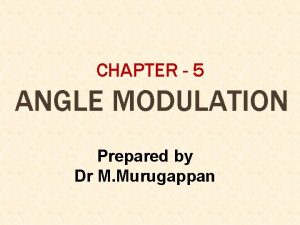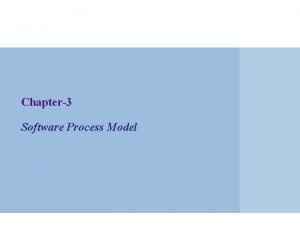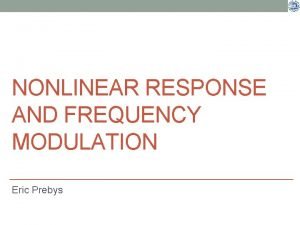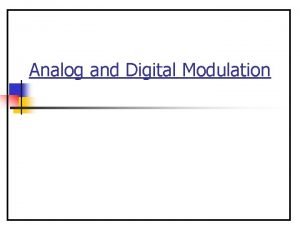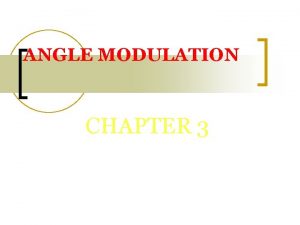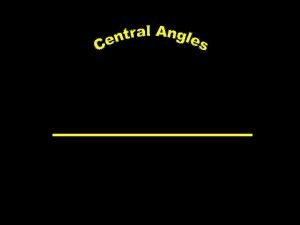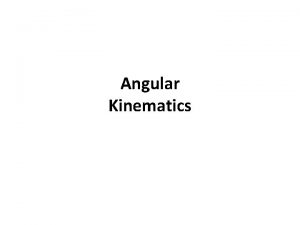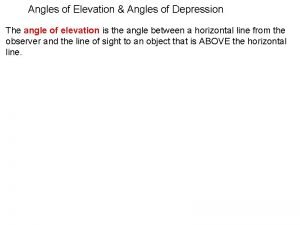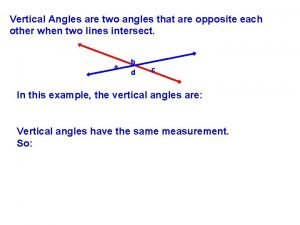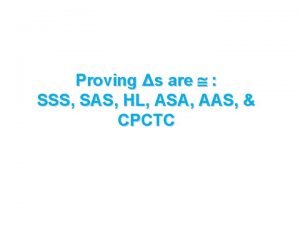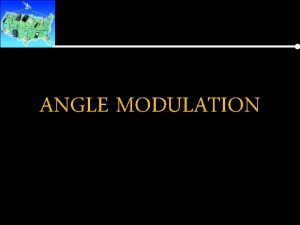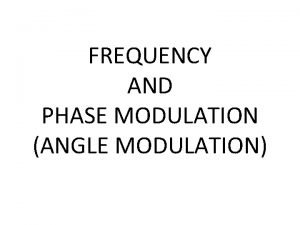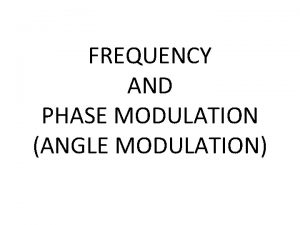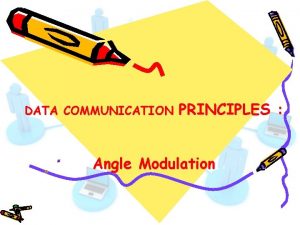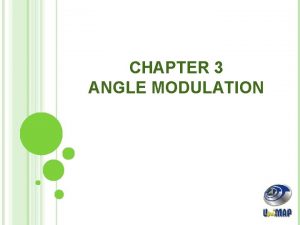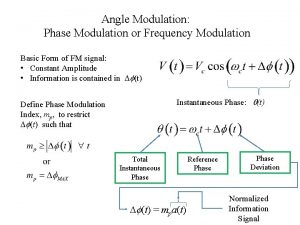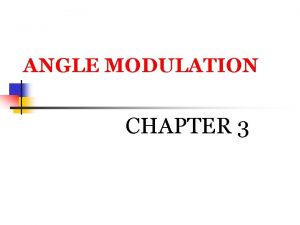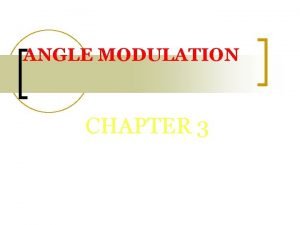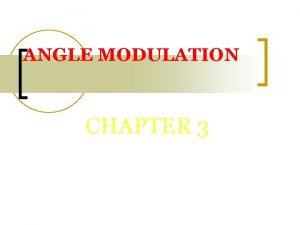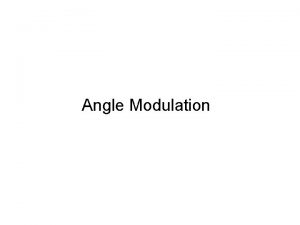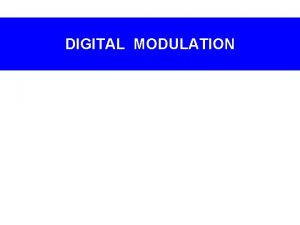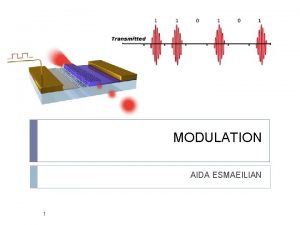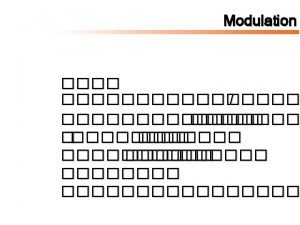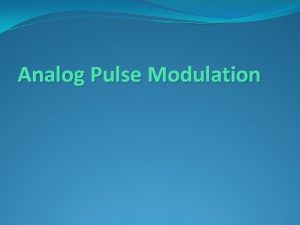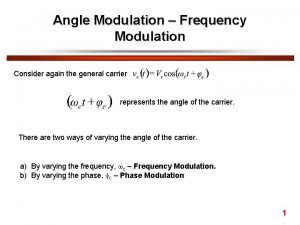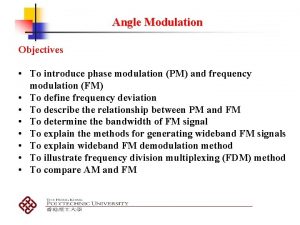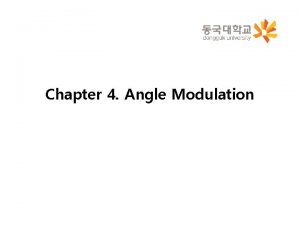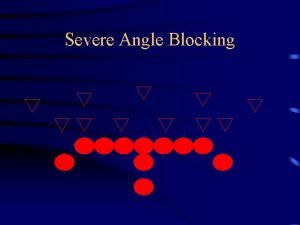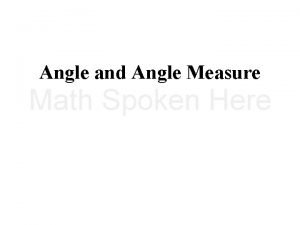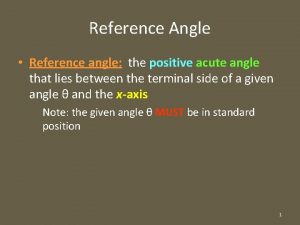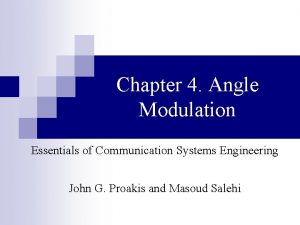Chapter3 Angle Modulation Introduction to Communication Systems 1440
























- Slides: 24

Chapter-3 Angle Modulation Introduction to Communication Systems 1440 H Second Semester (222 CNET -3) Mr. Haneef Khan Department of Computer & Network Engineering College of CS&IT Jazan University, Jazan.

Objectives 1. Analog Modulation and its types. 2. Basics of Sine and Cosine in term of amplitude, frequency and phase. 4. Frequency Modulation concept, equations and waveforms 5. Phase Modulation concept, equations and waveforms. 6. Numerical on FM and PM.

Introduction �There are three parameters of a carrier that may carry information: �Amplitude �Frequency �Phase �Frequency and Phase modulation are closely related and grouped together as phase modulation.

Types of Modulation �Types of Information • Analog • Digital These two constitute angle modulation. Carrier Variations Ø Amplitude Frequency Ø Phase Ø

Sine Signal And Cosine Signal Sine waveform Cosine waveform A sinusoid, meaning a sine wave -or- a cosine wave, is the basic building block of all signals.

What is Amplitude, Frequency, and Phase ? Vary one of these parameters ase Ph q Fre c n ue y p Am d litu e Angle modulation is a variation of one of these two parameters.

Difference between Amplitude, Frequency and Phase

Understanding Phase vs. Frequency V phase To understand the difference between phase and frequency, a signal can be thought of using a phasor diagram. The distance from the center is the signal's amplitude. The angle from the positive horizontal axis is the phase.

Understanding Phase vs. Frequency an (cha ha p e ng ch ( / ) se e) im ge t The change in the phase over time (the phase velocity) is the signal's frequency.

Signals vs NASCAR F In NASCAR, we track each car by its position on the track. In signals, we track the signal by its phase. This is its position on the phasor diagram.

Signals vs NASCAR In NASCAR, we track a car's velocity by how fast it goes around the track. In signals, we track the signal's velocity by its frequency. This is how fast it goes around the phasor diagram.

Frequency Modulation(FM) FM is technique of transmitting message signal using a radio-frequency carrier signal. The frequency of the carrier signal is varied accordance with the amplitude of the message signal, the amplitude of the carrier signal remain unchanged. FM ﻹﺭﺳﺎﻝ ﺇﺷﺎﺭﺓ ﻫﻲ ﺗﻘﻨﻴﺔ ﻳﺨﺘﻠﻒ. ﺍﻟﻼﺳﻠﻜﻲ ﺍﻟﺮﺳﺎﻟﺔ ﺑﺎﺳﺘﺨﺪﺍﻡ ﺇﺷﺎﺭﺓ ﺣﺎﻣﻞ ﺍﻟﺘﺮﺩﺩ ، ﻭﻓﺍ ﻟﺴﻌﺔ ﺇﺷﺎﺭﺓ ﺍﻟﺮﺳﺎﻟﺔ ﺗﺮﺩﺩ ﺇﺷﺎﺭﺓ ﺍﻟﻤﻮﺟﺔ ﺍﻟﺤﺎﻣﻠﺔ ﻭﺗﺒﻘﻰ ﺳﻌﺔ ﺇﺷﺎﺭﺓ ﺍﻟﻤﻮﺟﺔ ﺍﻟﺤﺎﻣﻠﺔ ﺩﻭﻥ ﺗﻐﻴﻴﺮ

FM Waveform

Equations 1. Message Signal vm = Vm sin(ωm + ϕm) 2. Carrier Signal vc = Vc sin(ωct + ϕc) Where, vm , vc = Instantaneous value of message and carrier signal. ωm , ωc = Angular velocity ϕm , ϕc = Phase Angle ωt represent angle in radian.

3. Modulated Signal v. FM = Vc sin(ωct + mf cos ωmt) Where, δf = Maximum deviation mf = Modulation Index = δf /fm



Waveform of PM

Equations 1. Message Signal vm = Vm sin(ωm + ϕm) 2. Carrier Signal vc = Vc sin(ωct + ϕc) Where, vm , vc = Instantaneous value of message and carrier signal. ωm , ωc = Angular velocity ϕm , ϕc = Phase Angle ωt represent angle in radian.

3. Modulated Signal v. PM= Vc sin(ωct + ϕc +mp cos ωmt) Where, mp = Modulation Index) = δp δp = Maximum deviation


Examples


END
 Advantages of angle modulation
Advantages of angle modulation Software requirement and design
Software requirement and design Chapter3
Chapter3 Amplitude modulation vs frequency modulation
Amplitude modulation vs frequency modulation Amplitude modulation vs frequency modulation
Amplitude modulation vs frequency modulation Formula for modulation index
Formula for modulation index 1440 minutes in hours
1440 minutes in hours 1920*1440
1920*1440 Angle similarity
Angle similarity Critical.angle formula
Critical.angle formula First angle vs third angle
First angle vs third angle An angle whose vertex is the center of a circle
An angle whose vertex is the center of a circle Hand cutting instruments in operative dentistry
Hand cutting instruments in operative dentistry Absolute angle vs relative angle
Absolute angle vs relative angle Two acute vertical angles
Two acute vertical angles In the diagram gh bisects ∠fgi
In the diagram gh bisects ∠fgi Angle klm and angle mln are complementary
Angle klm and angle mln are complementary Bisectors worksheet
Bisectors worksheet Angle addition postulate find the indicated angle measure
Angle addition postulate find the indicated angle measure Parallel and inclined extinction
Parallel and inclined extinction How to remember complementary and supplementary angles
How to remember complementary and supplementary angles Drilling definition
Drilling definition John wants to measure the height of a tree
John wants to measure the height of a tree Are angle 3 and angle 6 vertical angles yes or no
Are angle 3 and angle 6 vertical angles yes or no Aas postulate examples
Aas postulate examples
